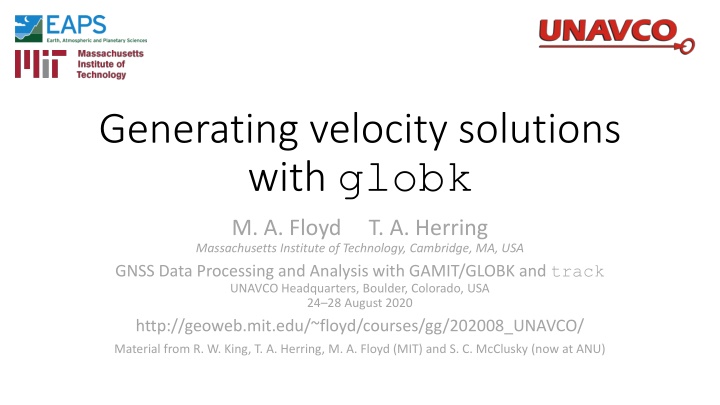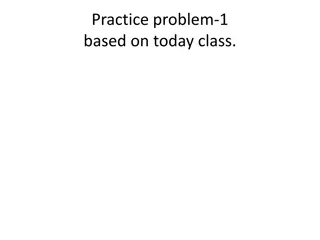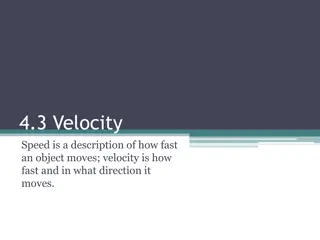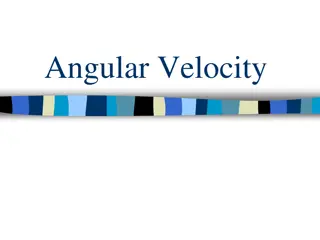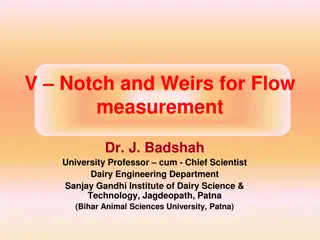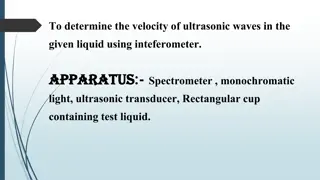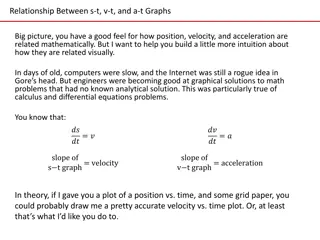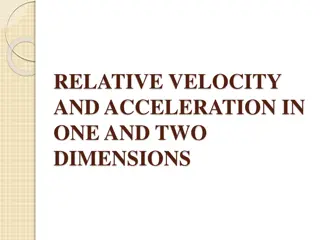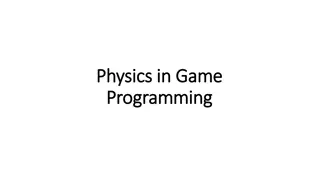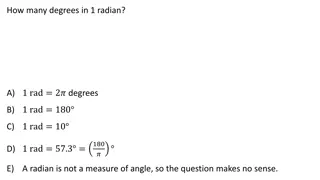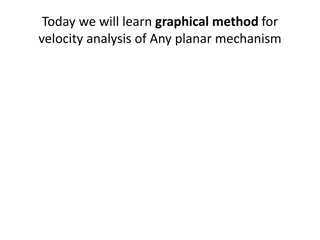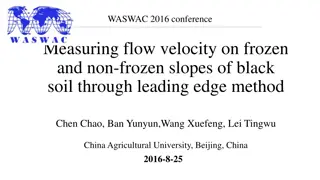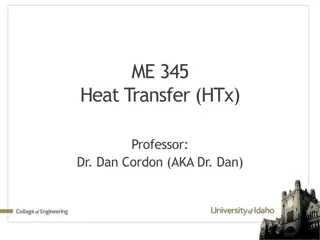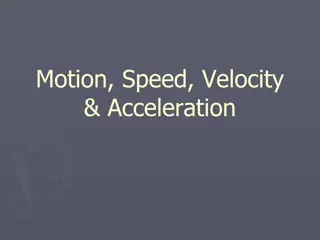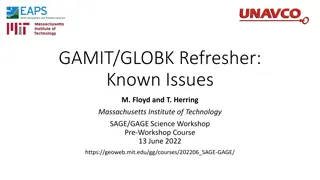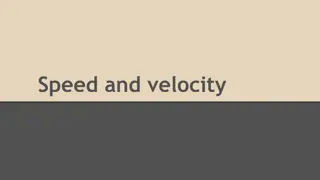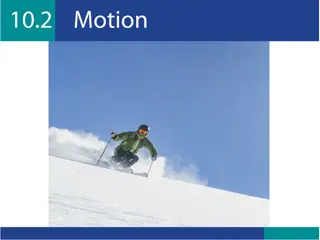Strategies for Generating Velocity Solutions with GLOBK
Basics of velocity solutions, setup strategies, and data cleaning methods for optimizing GLOBK solutions to generate position, velocity, offset, and postseismic parameter estimates. The aim is to combine years of data, make critical decisions on data treatment, and ensure accuracy in the process noise parameters. Careful setup and input requirements are crucial for successful velocity solution strategies.
Download Presentation

Please find below an Image/Link to download the presentation.
The content on the website is provided AS IS for your information and personal use only. It may not be sold, licensed, or shared on other websites without obtaining consent from the author.If you encounter any issues during the download, it is possible that the publisher has removed the file from their server.
You are allowed to download the files provided on this website for personal or commercial use, subject to the condition that they are used lawfully. All files are the property of their respective owners.
The content on the website is provided AS IS for your information and personal use only. It may not be sold, licensed, or shared on other websites without obtaining consent from the author.
E N D
Presentation Transcript
Generating velocity solutions with globk M. A. Floyd T. A. Herring Massachusetts Institute of Technology, Cambridge, MA, USA GNSS Data Processing and Analysis with GAMIT/GLOBK and track UNAVCO Headquarters, Boulder, Colorado, USA 24 28 August 2020 http://geoweb.mit.edu/~floyd/courses/gg/202008_UNAVCO/ Material from R. W. King, T. A. Herring, M. A. Floyd (MIT) and S. C. McClusky (now at ANU)
Overview Basics of velocity solutions Invoked with apr_neu all xx xx xx <NEU velocity sigmas> Strategies for setting up solutions (they can take a long time to run) Strategies for speeding up solutions Methods for cleaning up potential problems Different reference frame realizations Some examples These solutions involve making decisions about how to treat data and the type of solution to be created lots of decisions 2020/08/25 Generating velocity solutions with globk 1
GLOBK velocity solutions The aim of these solutions is to combine many years of data to generate position, velocity, offset and postseismic parameter estimates Increasingly common to have 10,000 parameters in these solutions if large networks over many years Input requirements for these solutions: a priori coordinate and velocity file Used as a check on positions in daily solutions (for editing of bad solutions) and adjustments are a priori values (a priori sigmas are for these values) Earthquake file which specifies when earthquakes, discontinuities, and misnamed stations affect solution Critical that this file correctly describe data. Process noise parameters for each station Critical for generating realistic standard deviations for the velocity estimates (e.g. sh_gen_stats). 2020/08/25 Generating velocity solutions with globk 2
GLOBK long-term velocities Combine daily (continuous) or short-term combined h-files (e.g. surveys; see last slide) Plot long-term time series from short-term combination .org -file(s) (sh_plot_pos) Inspect time series to identify (and remove) outliers Run globkto form final solution file for all data (another .org -file) with velocity estimation, e.g. in globk command file apr_site all 10 10 10 1 1 1 or apr_neu all 10 10 10 1 1 1 sh_glred capable of running all these individual commands to produce time series, short-term combinations and long-term velocity solutions 2020/08/24 Basics of processing workflow for GAMIT/GLOBK 3
Velocity solution strategies In general careful setup (i.e. correct a priori coordinates, earthquake file and process noise files) is needed since each run that corrects a problem can take several days. Incorrect solutions may not complete correctly and results may be subtly wrong. General strategy for iteratively generating velocity solution: Define a core-set of sites (usually 20-200 sites) where the solution runs quickly. Test files on this solutions and use the coordinate/velocity estimates to form the reference frame for time series generation. Time series using these reference frame sites and then test (RMS scatter, discontinuity tests) to form a more complete earthquake and apriori coordinate/velocity files. Steps above are repeated, usually increasing number of stations until solution is complete. As new stations are added missed discontinuities and bad process noise models can cause problems. Aim here is make sure that when a large solution is run (maybe several days of CPU time) that the run completes successfully. 2020/08/25 Generating velocity solutions with globk 4
Before velocity runs Surveys may be combined into one solution per survey No need to re-run glred again to see long-term time series Multiple .org -files may be read by tssum or sh_plot_pos tssum ts_pos mit.final_igb14 -R survey1_comb.org survey2_comb.org ... ts_pos is the name of a directory for the .pos files. ( . can be used) sh_plot_pos -f survey1_comb.org survey2_comb.org -k ... 2020/08/25 Generating velocity solutions with globk 6
Example: Long-term time series for survey sites Reasonable repeatability Outlier in vertical 2020/08/25 Generating velocity solutions with globk 7
Excluding outliers or segments of data Create rename file records and add to GLOBK command file s eq_file option, e.g. rename PTRB PTRB_XPS h1407080610_nb4a rename PTRB PTRB_XPS 2014 07 07 18 00 2014 07 08 18 30 rename ABCD ABCD_XCL 2013 07 08 00 00 XPS will not exclude data from glred (so still visible in time series) but will exclude data from globk (combination or velocity solution) XCL will exclude data from all glred or globk runs 2020/08/25 Generating velocity solutions with globk 8
Run globk Create new .gdl -file with combined binary h-files, e.g. from vsoln/, assuming standard directory hierarchy ls ../*/gsoln/*.GLX > vsoln.glx.gdl Optionally run glist to see size of solution Recommended to prevent problems during long globk run glist can read earthquake file and globk use site type commands (useful if a globk solution seems to be missing or has extra sites) Run globk This may take many hours for very large/long velocity solutions Use tsfit with earthquake file to generate a priori site coordinates. Be careful if ~/gg/tables/igb14_*.apr files also used because some site names permutations may have inconsistent coordinates (use unify_apr to be safe) 2020/08/25 Generating velocity solutions with globk 9
glorg for different reference frames No need to re-run globk every time you want glorg is usually called from globkcommand file ( org_cmd option) but glorg may be run separately globk 6 globk_vel.prt globk_vel.log globk_vel.gdl globk_vel.cmd glorg globk_vel_noam.org ERAS: glorg_vel.cmd vel.com Must have saved the .com -file! e.g. com_file @.com Do not use del_scra yes in globk command file apr_neu must be loosely constrained ( apr_rot and apr_tran will also need to be used for sestbl. BASELINE experiment solutions) 2020/08/25 Generating velocity solutions with globk 10
ITRF2014 2020/08/26 Reference frames 11
ITRF2014 What are some general features of plate motion that you can see? North America rotates around a point in the Pacific off South America Eurasia and Africa appear to have very similar motions Antarctica is moving very little ITRF2014 is a not-net-rotation frame which is a mathematical construction. For some geophysical problems other frames may make more sense (e.g., mantle fixed, hot spot frame, specific plate). Frames for different plates (based on Euler pole fits) are in ~/gg/tables. 2020/08/26 Reference frames 12
Choices of reference frame Choose your reference frame based on your geophysical objectives Velocities in ITRF are difficult to interpret visually from a geophysical perspective Local surroundings of a volcano One side of a fault Upper plate of a subduction zone Major plate reference frame Major plates are often chosen to conform with conventional perspectives of velocity solutions Relative to Eurasia, Nubia, North America, South America, etc. But don t feel restricted by this. Sometimes your geophysical discussion is best visualized relative to any stable boundary of a deforming region Regional reference frame Central Valley of California, non-deforming part of Anatolia, smaller coherent regions, etc. Local reference frame Sites near but outside the influence of a volcano, geothermal field, etc. 2020/08/26 Reference frames 13
Examples Expressing velocities in ITRF is not very meaningful or useful when we want to look at the deformation at a plate boundary, e.g. the San Andreas Fault system Better to look at velocities with one side fixed so we can see what the other side is doing relative to it NA PA NA PA 2020/08/26 Reference frames 14
Basic issues in reference frame realization Concept is to align the estimated site positions and possibly velocity to a set of well defined locations that have physical significance for the analysis being performed (e.g., GAGE aligns to a realization of the North America plate based on ITRF2014) glorg is the module which does this and computes the covariance matrix of the aligned solution in the reference frame chosen. Transformation is often called an N-parameter Helmert transformation N = 3: translation only (could also be just rotation) N = 6: translation and rotation N = 7: translation, rotation and scale In GLOBK analyses, you need to decide How many parameters (3/6/7) Sites to use to determine the parameters (sh_gen_stats) Values of the positions/velocities of the reference frame sites Weight to be given to heights in computing the transformation parameters ( cnd_hgtv command; first two arguments for position and velocity, other arguments are sigma limits) 2020/08/26 Reference frames 15
Rules for stabilization of time series Small-extent network: translation-only in glorg, must constrain EOP in globk Large-extent network: translation and rotation, must keep EOP loose in globk If scale estimated in glorg, must estimate scale in globk First pass for editing: Adequate stab_site list of stations with accurate a priori coordinates and velocities and available most days Keep in mind deficiencies in the list Final pass for presentation, assessment and statistics Robust stab_site list of all/most stations in network, with coordinates and velocities determined from the final velocity solution System is often iterated (velocity field solution, generate time series, editing and statistics of time series; re-generate velocity field) If you have time series, you can test options using tscon 2020/08/26 Reference frames 16
Use of equates With earthquakes and discontinuities, there can be many site names for the same physically location: Equate commands in glorg allow the velocity adjustments at these sites to be made the same (or constrained to be the same within a specified sigma) eq_dist allows site separate by distance to equated (and constrained in latest glorg) eq_4char equates sites with same 4-character name (useful to stop equates at sites that share antennas) chi-squared increments of equates allows assessment of equates (use unequate for large chi-squared values) Use FIXA option to make a priori the same for equated sites (better to use consistent a priori file) 2020/08/25 Generating velocity solutions with globk 17
Uses of sh_gen_stats Velocity solutions are often iterative: Generate time series using some reference frame sites (IGb14 sites initially for example) Fit to the time series (tsfit) to: Find outliers, nature of earthquakes (log needed?), discontinuities Self consistent a priori file. Used FOGMEx model (realistic sigma) to get process noise model and list of low- correlated noise reference frame sites). Use stabrad option for dense networks Run globk velocity solution to refine reference frame site coordinates and velocities Re-generate time series and repeat 2020/08/25 Generating velocity solutions with globk 18
Some comparisons: Approach Use sh_exglk -f <soln.org> -vel <soln.vel> -rmdup to extract velocity estimates (rmdup removes equated sites with the same estimates) Program velrot allows fields to be compared (change frames and merge fields as well), for example: velrot solna.vel nam14 solnb.vel IGb14 N compares to solutions directly (use RT instead of N to allow rotation and translation rates) Use grep ^S to get statistics 2020/08/25 Generating velocity solutions with globk 19
Comparisons: Decimation Decimation: Different days of week (1996-2015 solution, small subset of sites): Un-aligned fields compare 1 NMT_vel_150418_day1.vel NMT_vel_150418_day3.vel S Component North # 75 WMean -0.00 WRMS 0.04 mm/yr, NRMS 0.198 S Component East # 75 WMean -0.02 WRMS 0.04 mm/yr, NRMS 0.203 S Component Up # 75 WMean 0.03 WRMS 0.16 mm/yr, NRMS 0.180 S Component Horz # 75 WMean -0.01 WRMS 0.04 mm/yr, NRMS 0.200 compare 2 NMT_vel_150418_day1.vel NMT_vel_150418_day5.vel S Component North # 74 WMean -0.01 WRMS 0.04 mm/yr, NRMS 0.207 S Component East # 74 WMean -0.02 WRMS 0.05 mm/yr, NRMS 0.225 S Component Up # 74 WMean 0.04 WRMS 0.19 mm/yr, NRMS 0.212 S Component Horz # 74 WMean -0.01 WRMS 0.04 mm/yr, NRMS 0.217 compare 3 NMT_vel_150418_day3.vel NMT_vel_150418_day5.vel S Component North # 76 WMean -0.01 WRMS 0.03 mm/yr, NRMS 0.177 S Component East # 76 WMean -0.01 WRMS 0.03 mm/yr, NRMS 0.161 S Component Up # 76 WMean 0.01 WRMS 0.13 mm/yr, NRMS 0.142 S Component Horz # 76 WMean -0.01 WRMS 0.03 mm/yr, NRMS 0.169 2020/08/25 Generating velocity solutions with globk 20
Comparison: Time series vs GLOBK PBO Combined analyses: Un-aligned fields (no rotation and translation). compare 1 PBO_vel_150425.vel PBO_vel_150425KF.vel S Component North # 2105 WMean -0.01 WRMS 0.12 mm/yr, NRMS 0.925 S Component East # 2105 WMean -0.00 WRMS 0.13 mm/yr, NRMS 0.934 S Component Up # 2105 WMean 0.02 WRMS 0.31 mm/yr, NRMS 0.871 S Component Horz # 2105 WMean -0.01 WRMS 0.12 mm/yr, NRMS 0.929 compare 4 PBO_vel_150425.vel PBO_vel_150425_NAM08.vel S Component North # 1972 WMean 0.03 WRMS 0.13 mm/yr, NRMS 0.965 S Component East # 1972 WMean 0.02 WRMS 0.15 mm/yr, NRMS 1.049 S Component Up # 1972 WMean -0.07 WRMS 0.41 mm/yr, NRMS 0.943 S Component Horz # 1972 WMean 0.02 WRMS 0.14 mm/yr, NRMS 1.008 compare 7 PBO_vel_150425KF.vel PBO_vel_150425_NAM08.vel S Component North # 1969 WMean 0.04 WRMS 0.16 mm/yr, NRMS 0.952 S Component East # 1969 WMean 0.02 WRMS 0.17 mm/yr, NRMS 0.967 S Component Up # 1969 WMean -0.08 WRMS 0.44 mm/yr, NRMS 0.935 S Component Horz # 1969 WMean 0.03 WRMS 0.16 mm/yr, NRMS 0.959 PBO_vel_150425.vel: tsfit solution to time series PBO_vel_150425KF.vel: tsfit Kalman filter solution to timeseries PBO_vel_150425_NAM08.vel: GLOBK combined velocity solution (NMT+CWU), decimated 7 days, 28-subnet combination. Reference frame realization to NAM08 frame sites (~600) See Herring et al., Reviews of Geophysics, 2016 for more detailed comparisons 2020/08/25 Generating velocity solutions with globk 21
Final comments Practice large solutions with decimated data sets and small networks (run time increased cubically with number of stations) Make sure your a priori coordinates files are consistent (especially with equates) Use the out_aprf command in tsfit to generate an a priori which is consistent with your timeseries estimates 2020/08/25 Generating velocity solutions with globk 22
